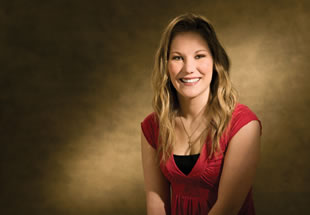Julie Vandervoort doesn’t remember being ejected from her car as it rolled several times after leaving the gravel road. She can’t recall the car landing on top of her, the hot exhaust manifold searing her flesh. She was conscious, and she pounded on the undercarriage until two passersby heard her and called for help. A helicopter flew her to The University of Kansas Hospital, and her difficult journey to recovery began.

She was badly hurt, suffering third and fourth-degree burns from the waist down causing severe skin, muscle and even bone damage, a broken pelvis, and a shattered pubic bone. She would lose her right leg below the knee.
A two month stay in the hospital followed with several debridements to remove dead tissue, then skin and muscle grafts to repair damaged tissue. During one surgery alone, Julie required seven units of blood and two units of plasma. Overall, she needed 34 units of blood to get her through 15 surgeries before she was released to undergo two weeks of inpatient rehabilitation at St. Francis Hospital in Topeka, Kansas.
Through it all, Julie had the support of a loving family and people she’d never met, including the anonymous blood donors. Her mother started caringsite.org to blog about Julie’s progress. Thousands of people read it the first day. Julie started receiving cards from total strangers. Receiving those cards became the highlight of her days.
Julie’s accident happened in 2007, two years after she graduated from high school. Today, she is still in outpatient rehabilitation, but her mind is on the future and what she can do for people who have suffered illness or injury that could be fatal without donated blood.
Every year, Julie’s former high school holds a blood drive. She saw a notice for the 2008 drive in the paper and decided to do something. A phone call got her permission to tell her story to the student donors. She did, and a record number showed up to give blood.
Maybe it was the story of her accident and the lifesaving blood she received that did the trick. Or maybe it was more–an empathy she feels for people who hesitate about giving and a perspective few have on the importance of donated blood.
“I used to be the same way,” she says. “I hated the idea of the needle. But what the blood is for outweighs what little pain you might go through.”
As for the future, Julie wants to be a physical therapist, and she would like to talk to middle school girls about self-esteem. Chances are she’ll tell them her story and instill the idea that one good way to gain self-esteem is to give of oneself.
